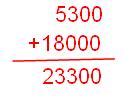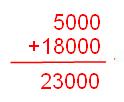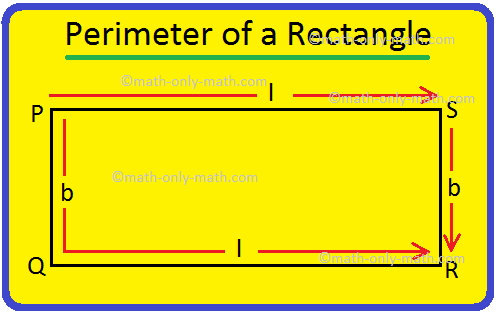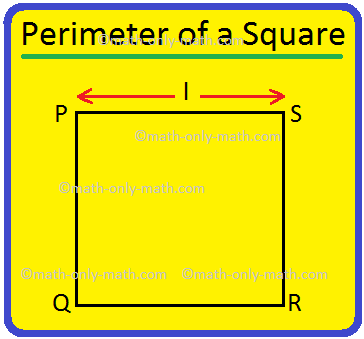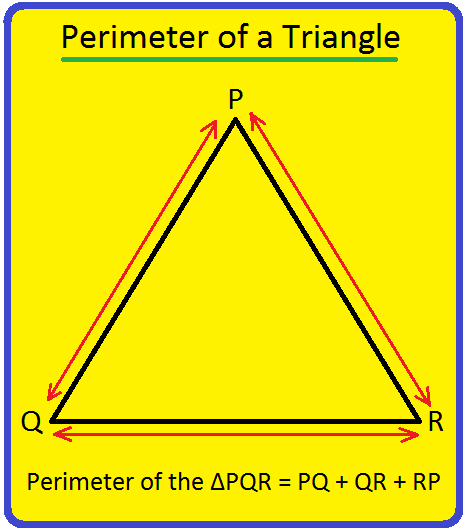Estimating Sum and Difference
The procedure of estimating sum and difference are in the following examples.
Example 1:
Estimate the sum 5290 + 17986 by estimating the numbers to their nearest (i) hundreds (ii) thousands.
Solution:
(i) Estimating the numbers 5290 and 17986 to their nearest hundreds, we get 5300 and 18000 respectively.
We have,
Therefore, estimated sum is 23300.
(ii) Estimating the numbers 5290 and 17986 to their nearest
hundreds, we get 5000 and 18000 respectively.
We have,
Therefore, estimated sum is 23000.
Example 2:
Estimate: 5673 – 436 by rounding off the numbers to their greatest places. Also,, find the reasonable estimate.
Solution:
We have, 5673 – 436 = 5237.
The greatest place in 5673 is thousands place and in 436 the greatest place is hundred place.
Estimating 5673 to nearest thousands, we get 6000
Estimating 436 to nearest hundreds, we get 400
Therefore estimated difference = 6000 – 400 = 5600
Clearly, it is not closer to the actual difference. So, it is not a reasonable estimate.
Let us round off 5673 and 436 to nearest hundreds.
5673 rounds off as 5700.
436 rounds off as 400
Therefore estimated difference = 5700 – 400 = 5300
Example 3:
Give a rough estimate and also a closer estimate of 489342 – 48365.
Solution:
We have,
489342 – 48365 = 440877
To find rough estimate, let us round off each number to nearest ten thousands.
489342 rounds off as 490000
48365 rounds off as 50000
Estimates difference = 490000 – 50000 = 440000
So, rough estimate = 440000
In order to obtain a closer estimate, let us round off each number to nearest thousands.
489342 rounds off as 489000
48365 rounds off as 48000
Estimated difference = 489000 – 48000 = 441000
Clearly, it is closer to the actual difference 440977Hence, closer estimate is 441000
● Estimate
Estimating Product and Quotient
Numbers Page
6th Grade Page
From Estimating Sum and Difference to HOME PAGE
Didn't find what you were looking for? Or want to know more information about Math Only Math. Use this Google Search to find what you need.
Recent Articles
-
Perimeter of a Rectangle | How to Find the Perimeter of a Rectangle?
Apr 25, 24 03:45 PM
We will discuss here how to find the perimeter of a rectangle. We know perimeter of a rectangle is the total length (distance) of the boundary of a rectangle. ABCD is a rectangle. We know that the opp… -
Perimeter of a Square | How to Find the Perimeter of Square? |Examples
Apr 25, 24 12:54 PM
We will discuss here how to find the perimeter of a square. Perimeter of a square is the total length (distance) of the boundary of a square. We know that all the sides of a square are equal. Perimete… -
Perimeter of a Triangle | Perimeter of a Triangle Formula | Examples
Apr 25, 24 12:53 PM
We will discuss here how to find the perimeter of a triangle. We know perimeter of a triangle is the total length (distance) of the boundary of a triangle. Perimeter of a triangle is the sum of length… -
Dividing 3-Digit by 1-Digit Number | Long Division |Worksheet Answer
Apr 24, 24 03:46 PM
Dividing 3-Digit by 1-Digit Numbers are discussed here step-by-step. How to divide 3-digit numbers by single-digit numbers? Let us follow the examples to learn to divide 3-digit number by one-digit nu… -
Symmetrical Shapes | One, Two, Three, Four & Many-line Symmetry
Apr 24, 24 03:45 PM
Symmetrical shapes are discussed here in this topic. Any object or shape which can be cut in two equal halves in such a way that both the parts are exactly the same is called symmetrical. The line whi…
